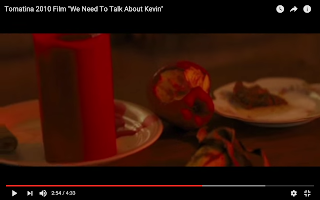DECONSTRUCTING HANNA (shot by shot)
Shot:
- Misty, grey, snowy, empty landscape. Panning.
- Fade into second shot of snowy landscape, icy water with trees on horizon. Vignette edged, blurred.
- Cut to medium wide shot of running water, snow. Swan is seen. Diegetic sounds of water running, no music/soundtrack.
- Birds-eye view of an icy lake.
- Shot of a baby arctic fox.
- Cut to woody area. Panning across. Figure is seen in heavy furs holding a bow and arrow, poised. Camera pans across in front of tree - the figure has then vanished.
- Panning across another place within woody area. Moose is seen walking.
- Panning across opposite side again, figure is stood behind two thin trees.
- Pans across on moose.
- Close up panning on Hanna’s hiding place and her striking blue eye between the trunks.
- Quick cut to her pull back her bow and arrow
- Close up of the arrow firing. Can hear the arrow fly through the air.
- Fleeting glimpse of moose’s eyes.
- Close up of arrow impaling the moose’s body.
- Quick, dramatic cut to moose’s startled eyes. It howls in pain.
- Quick cut to moose running. Can hear its feet in the snow.
- Cut to Hanna chasing after. Can hear her heavy breathing and feet in the snow.
- Cut back to moose.
- Shaky POV shot (of moose) - blurred trees. Vignette around edge.
- Cut back to Hanna.
- Wide shot of moose running into flat, snowy expanse of landscape.
- Cut back to Hanna continuing to pursue it.
- Medium close up shows the moose now walking.
- Wide shot of moose struggling to continue. Noises of pain are heard.
- Cut back to Hanna, still running.
- Close up of moose’s head collapsing - is apparent its body has already fallen to the ground. Exhale of breathe is heard.
- Extreme close up of rolled, bloodshot eye. Hanna can be seen in the reflection of the eyeball. Moose’s struggling breaths are heard.
- Cut to close up of Hanna removing the arrow from the body. Another noise of pain.
- Camera from below shows Hanna standing up above the moose, blocking out the sun. She looks down on us.
- Medium close up. She pulls down the fabric covering her mouth. ‘I just missed your heart’, she says. Noises of pain can still be heard. She reveals a gun from below the shot. Points it straight at the camera - gun comes into focus. She shoots it - the shot is heard.
- Cuts to ‘HANNA’ - white writing on bright red background.
What can we establish from a two-minute opening?
- We are able to be introduced to the main characters - we are given an idea of their current situation and their motives.
- The audience is able to start guessing and anticipating what is going to happen throughout the film from the information we are given; their may be foreshadowing, symbolism, flashbacks or a set up to give the audience ideas.
- A backstory may even be introduced - this gives further context and richness to the opening; drawing the audience in.
- A question/questions are posed to the audience to keep them guessing and building tension.
- We are clearly shown the style and tone of the film through the use of sound (absence/presence of soundtrack and the tone of this music), the chosen colour palette, the location and the speed of editing (fast paced/slow paced).





































